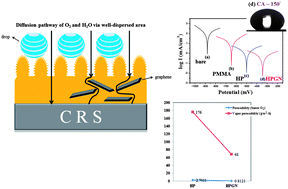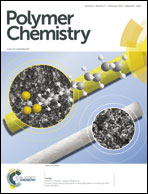Synergistic effects of hydrophobicity and gas barrier properties on the anticorrosion property of PMMA nanocomposite coatings embedded with graphene nanosheets†
Abstract
In this paper, the surface of a PMMA/graphene nanocomposite (PGN) with biomimetic hydrophobic structures was first prepared by the nanocasting technique and applied in corrosion protection coatings. First of all, a transparent soft template with negative patterns of a Xanthosoma sagittifolium leaf can be fabricated by thermal curing of the polydimethylsiloxane (PDMS) pre-polymer in molds at 60 °C for 4 h, followed by detaching the PDMS template from the surface of the natural leaf. Subsequently, PGN with a hydrophobic surface (HPGN) of the biomimetic natural leaf was fabricated, using PDMS as the negative template, through casting onto a cold rolled steel (CRS) electrode. The surface morphology of as-synthesized hydrophobic PMMA (HP) and PGN coatings was found to show lots of micro-scaled mastoids, each decorated with many nano-scaled wrinkles, which were investigated systematically by scanning electron microscopy (SEM). The contact angle (CA) of a water droplet on the sample surface can be increased from ∼80° for the PMMA surface to ∼150° for HP and HPGN and the sliding angle (SA) decreased from ∼60° to 5°. The morphological studies of the dispersion capability of graphene nanosheets (GNSs) in the polymer matrix can be carried out by observation under a transmission electron microscope (TEM). It should be noted that HPGN coating was found to reveal an advanced corrosion protection effect on the CRS electrode as compared to that of neat PMMA and HP coatings based on a series of electrochemical corrosion measurements in a 3.5 wt% NaCl electrolyte. The enhancement of corrosion protection of HPGN coatings on the CRS electrode could be interpreted by the following two possible reasons: (1) the hydrophobicity repelled the moisture and further reduced the water/corrosive media adsorption on the epoxy surface, preventing the underlying metals from corrosion attack, as evidenced by contact angle (wettability) measurements. (2) The well-dispersed GNSs embedded in the HPGN matrix could hinder corrosion due to their relatively higher aspect ratio than clay platelets, which further effectively enhance the oxygen barrier property of HPGN, as evidenced using a gas permeability analyzer (GPA).


 Please wait while we load your content...
Please wait while we load your content...